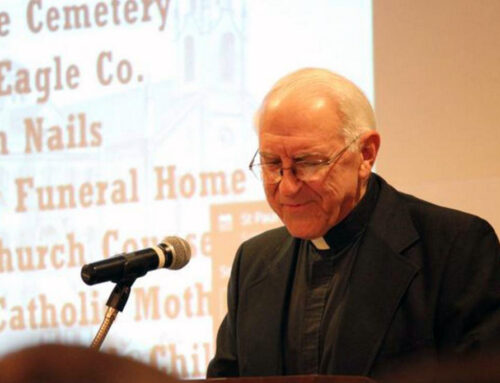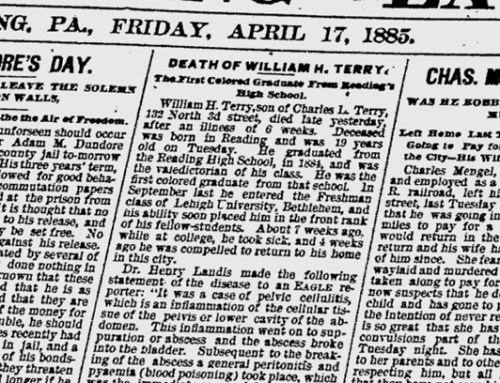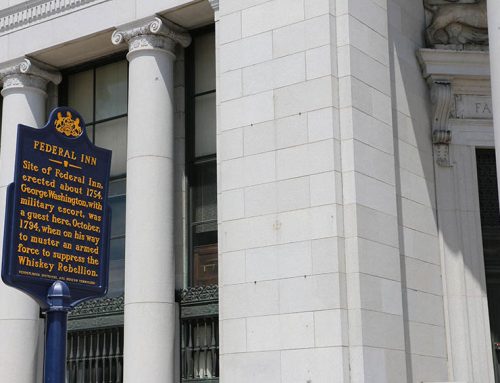The original public building in Reading stood in the center of Penn Square, directly at the intersection of Penn and Fifth Streets, then called Market and Callowhill Streets. It was the most central situation, and therefore the most convenient, and it was architecturally the finest possible location for a public building. On all sides it was open, with ample provision for light and air, and from every direction it could be seen to advantage. For nearly a hundred years (until about 1841) this building served also as a City Hall.
Below: First Court House and City Hall – 5th and Penn.

In 1909 John Nolen, city planner, of Cambridge, MA, was engaged by private interests to recommend a site or sites for a New City Hall and Court House.
His findings were published in a bound book titled “Replanning Reading.” In chapter four of his report to the Civic Association of Reading, Mr. Nolen discussed “Location of Public and Semi-Public Buildings.”
In this part of the report, he said: “The idea of grouping public buildings appears never to have been seriously considered in Reading. As a result, the Court House, the City Hall, the Post Office and other public or semi-public edifices, are scattered about on to minor streets occupying relatively small lots. This is a mistake, for it is a gain in convenience to both the general public and officials to have such buildings brought together, and it is likewise a gain in the attempt to secure impressive and appropriate architectural effect.”
Reading’s opportunity was not yet closed. With the exception of the Post Office, it had no permanent public building, none adequate for the present demands upon it. The Court House was small and cramped. The City Hall, a three-story brick building, constructed in 1870 at a cost of but $26,000 was by 1909 obviously unfit. The Public Library was in the same class, and, when hotels, club-houses, an art gallery, places of amusement, etc., were added, it became clear that the people of Reading had ahead of them an important constructive period, one which afforded an opportunity to build in a way that was fitting for a city of wealth, size, and assured future.
With Penn Square given over completely to commercial uses and the central section of the city built up solidly, it was difficult to conceive of an attractive situation for a permanent group of public buildings. The best opportunity appeared to John Nolen to be at Fifth and Washington Streets, but one block north of Penn Street.
Below: Fifth and Washington (1909).

The Post Office was located on the south-east corner of this intersection, and the other corners were all occupied by small stores. Private enterprise had already recognized the value of the situation, and secured the refusal of a large tract on the north-east corner, 120 feet by 165 feet, for a modern fire-proof hotel.
Across from the Post Office was a suitable site for a New City Hall, and the fourth corner a Public Library, Court House, Art Museum, Opera House, or something else of general public service.
Below: Suggestion for Grouping of Public Buildings – Fifth and Washington (1909).

The best alternative to Fifth and Washington Streets would have been to go farther north on Fifth Street and purchase from two to four blocks for a civic centre. The advantages would have been cheaper land and a possibility of a more open and more artistic grouping of buildings.
Such a plan, however, would have required the investment of a very large sum of capital; yet it might have proven not only practicable, but profitable, as the Pennsylvania legislature passed a law in 1907 by which Pennsylvania cities were given power within certain limitations to condemn land for public purposes, and such lands as are not required for improvements may be resold, with or without restrictions concerning future use and occupation, so as to protect public works and their environments.
Under this law the Philadelphia Parkway from the City Hall to Fairmount Park in Philadelphia was constructed. In its provisions this law corresponded in general with some other American States and with those of European countries. It should have enabled the City of Reading to provide not only more perfectly, but also at less expense for the public buildings, playgrounds, boulevards, and parks.






Leave A Comment